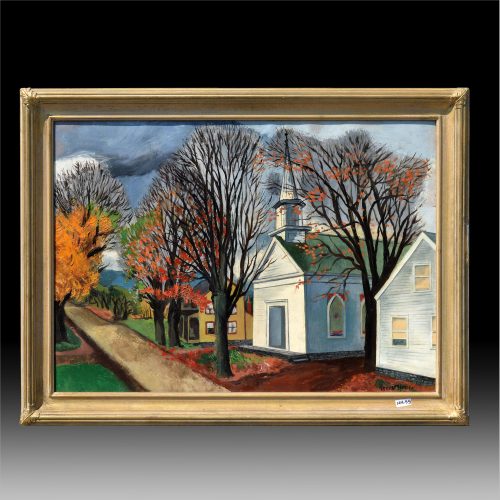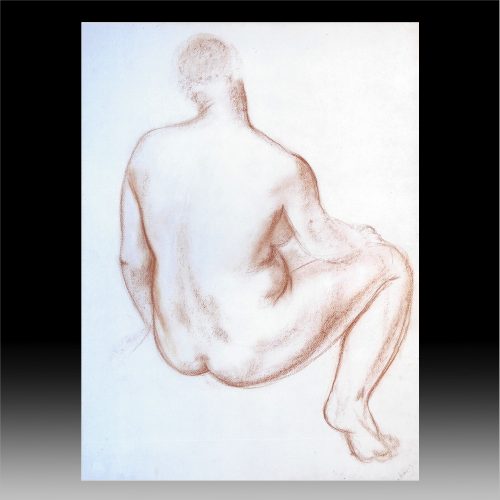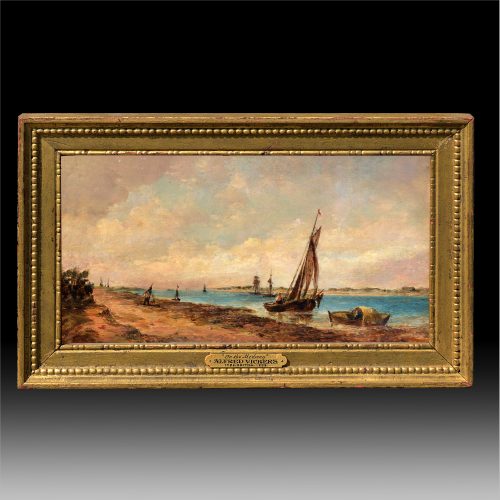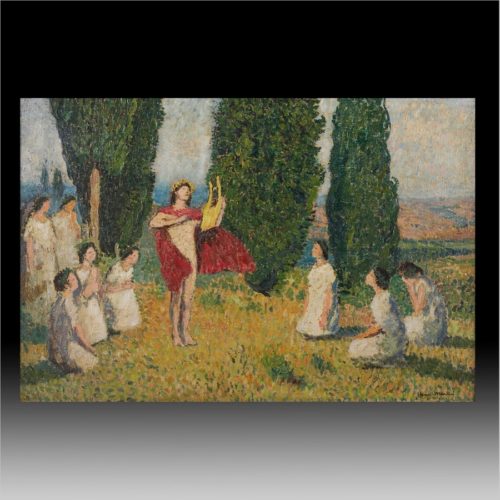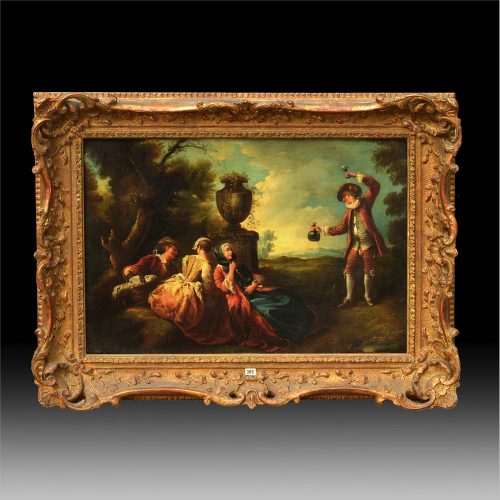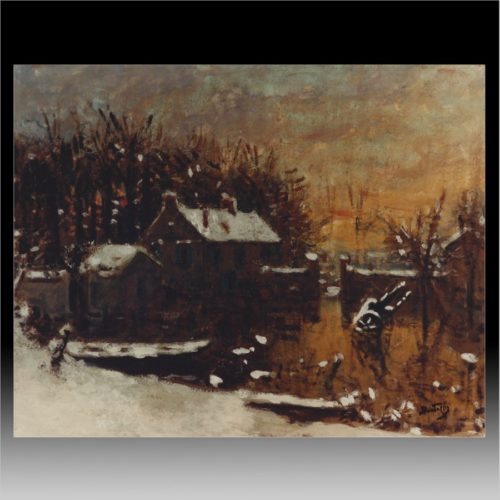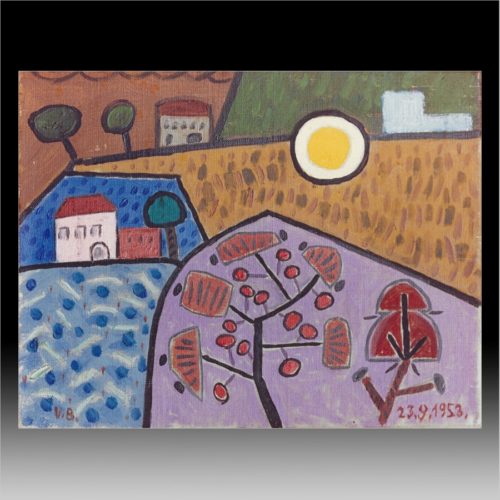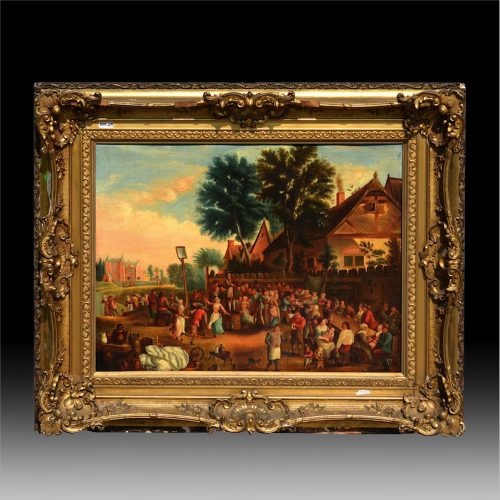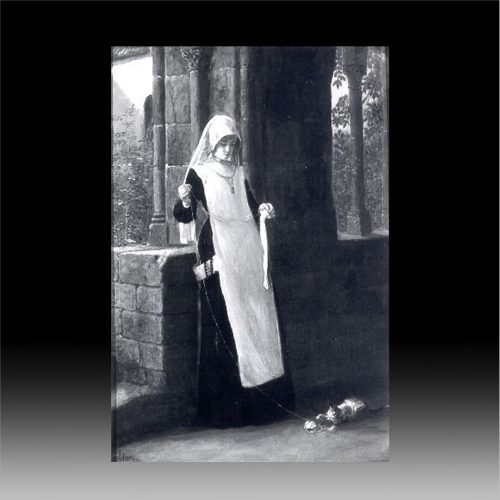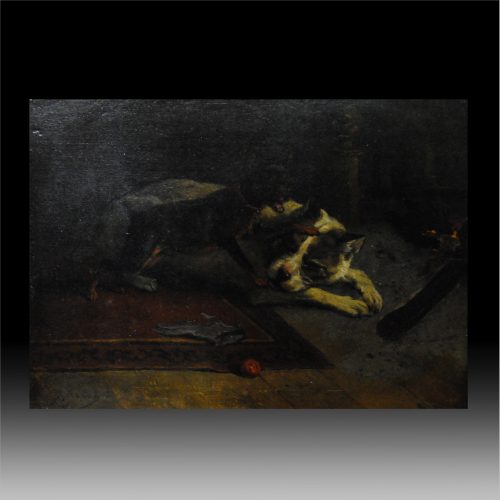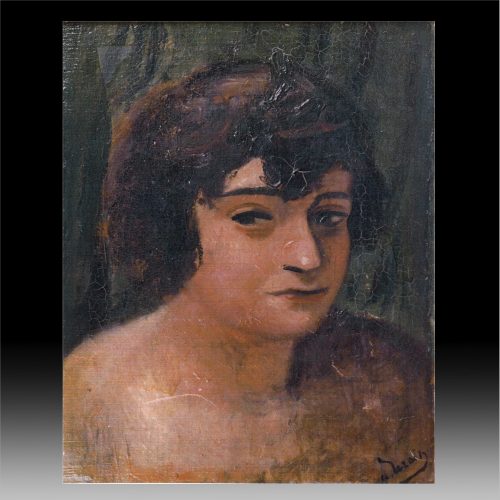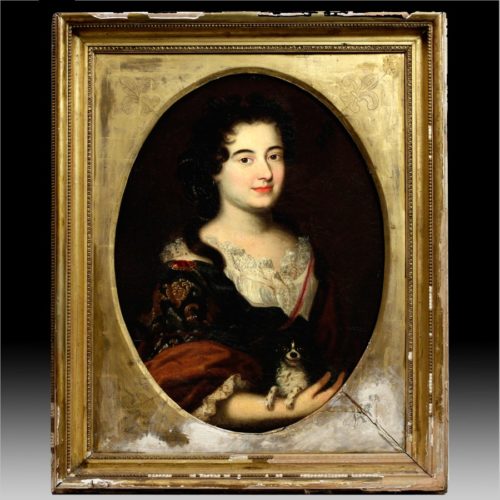-
Sale!
Ernest Fiene (American, 1894-1965) "New England Church" Oil on canvas 26 x 36 ½ in. Ernest Fiene (1894–1965) was a 20th-century American graphic artist who primarily worked in New York City and Woodstock, New York. Fiene was known primarily for his varied printed works, including lithographs and etchings. His notable work includes cityscapes, views of New York City in particular, landscapes and other figural art. Born in Germany in 1894, Fiene fled his native land in 1912 to avoid military service in what would become World War I. Traveling first to the Netherlands, he continued on to the United States. From 1914 to 1914 he studied at the National Academy of Design in New York City, and from 1916 to 1918 at the Beaux Arts Institute. In 1923, Fiene continued his study of printmaking at the Art Students League of New York. In 1921 he married Jeannette Etarre. From 1928 to 1929 he studied in Paris and traveled in France. Fiene was hired in 1940, along with eight other prominent American artists, to document dramatic scenes and characters during the production of the film The Long Voyage Home, a cinematic adaptation of Eugene O'Neill's plays. In 1945 he divorced his first wife and was married to Alicia Wiencek. Fiene re-established his relationship with the Art Students League in 1948, returning to teach classes in painting and drawing there. In 1948, he was elected into the National Academy of Design as an Associate member, and became a full Academician in 1952. In the 1950s he also served on the faculty of the Famous Artists School in Westport, Connecticut. Fiene died of a heart attack in Paris in 1965.
-
André Derain (French, 1880-1954) “Nu assis de dos” Red chalk on paper mounted on board 25” x 18 ½” Signed bottom right COA by M. Kellermann PROVENANCE: D.G. Kelekian, NY Estate of Elizabeth Norcott Exhibited Paris, Le Petit Palais, 1937 Chicago, the art institute, 18th International exhibition of watercolors, pastels, drawings and monotypes, March-May, 1939, no. 119 Minneapolis, Art Institute, 1940
-
Sale!
Alfred Vickers (British, 1786-1868) "On the Medway" Oil on canvas A beautiful horizontal scape of the shore with sailboats dispursed in the water, and two figures on the shore. Delicately painted clouds above, and a blend of colours that meet the horizon. Frame contains plaque of Title, Artist name, and descent.
-
Henri Martin (French, 1860-1943) “Orphee” Oil on canvas 21 ¼” x 32” Signed lower right COA by David Roy Henri-Jean Guillaume Martin (5 August 1860 – 12 November 1943) was a renowned French impressionist painter. Born in Toulouse to a French cabinet maker and a mother of Italian descent, Martin successfully persuaded his father to permit him to become an artist. He began his career in 1877 at the Toulouse School of the Fine Arts, where he was under the tutelage of Jules Garipuy (he was also a pupil of Henry-Eugéne Delacroix). In 1879, Martin relocated to Paris and with the help of a scholarship, was able to study in Jean-Paul Laurens' studio. Four years later, he received his first medal at the Paris Salon, where he would hold his first exhibition three years later in 1886. The year after he won his first medal, Martin was awarded a scholarship for a tour in Italy, where he studied the work of veterans such as Giotto and Masaccio. His 1889 canvas submission to the Salon earned him the gold medal for work that has been described as Pointillist. That same year he became a member of the Legion of Honour. At the 1900 World Fair, he was awarded the Grand Prize for his work. During this period, he became friends with Auguste Rodin. Although Martin's work as a neo-impressionist is not considered groundbreaking, his work was rather well-received, and has been associated with world-class symbolist painter, Puvis de Chavannes. Due to his introverted temperament, Martin decided to move away from Paris. After a decade of searching for an ideal home, Martin bought Marquayrol, a mansion overlooking La Bastide du Vert, near Cahors. He performed his best work in the new tranquil environment, and died there in 1943. Martin also taught; among his pupils was the American painter Nellie Ellen Shepherd.
-
Unknown Artist 19th Century “Outdoor Scene”
-
Pierre Montezin ( French, 1874-1946) “Paysage sous neige” Oil on paper mounted on canvas 29”x 36” Signed lower right PROVENANCE: Wally Findlay Gallery, NY 1961
-
Victor Brauner (Rumanian, 1903-1966) “Paysage” Oil on Canvas 7 ½”x 9” Signed bottom left Dated 1953 COA by S. Kinge PROVENANCE: Alexander Iolas, NY Exhibited: New York, Bodley Gallery, Victor Brauner,1961
-
Dutch/Flemish School, ca. 1800 ‘Peasants Dancing Outside an Inn’ Oil on canvas 26 ½ x 32 ½ in. (67.3 x 82.6 cm)
-
Sale!
L Roekler (German, 19thCent.) 'Playing with the cat’ signed and dated 73, oil on canvas 25 x 18 in. (63.5 x 45.7 cm)
-
Sale!
Charles Michael Verlat (Belgian, 1824-1890) Playmates Oil on panel, signed. 6 ¼ x 8 5/8 inches
-
André Derain (French, 1880-1954) “Portrait de la cortessa di Fraso” Oil on canvas 11” x 9” Signed lower right COA by M. Kellermann PROVENANCE: D. G. Kelekian, Paris Elizabeth Norcott Exhibited: San Francisco, Museum of Art, 1938 (on loan)
-
Henri Gascars ‘Portrait of a Lady, half length in a blue Dress with a white Chemise and a brown Wrap, holding a Spaniel' Bears inscription on a label on the reverse ‘Mrs. Cunliffe' oil on canvas, in a painted oval 27 x 19 ½ in. 68.6 x 49.5 cm. Henri Gascar (1635 – 1 Jan 1701) (also Gascard, Gascars) was a French-born portrait painter who achieved artistic success in England during the reign of Charles II. He painted many leading ladies at court, including several of the King's mistresses, before returning to Paris. He subsequently relocated to Rome, where he died in 1701. Gascar came to England about 1674, probably at the behest of Louise de Keroualle, Duchess of Portsmouth, Charles II's favourite mistress. Gascar (or Gascard, as he seems to have spelt his name at first) was already known as a skillful portrait-painter; among the portraits already painted by him was that of Nicolas de Lafond, author of the "Gazette of Holland", painted in 1667, and engraved by Peter Lombart. The patronage of the Duchess of Portsmouth ensured Gascar a rapid success in England. His flamboyant style, contrasting with the stolid English approach, seemed to suit the frivolity of the time and he painted many of the ladies of Charles II's court. His lack of attention to detail in the likeness he made up for by the sumptuous draperies and tawdry adornments around the subject. For a short time he became fashionable, and is said to have amassed a fortune of over £10,000.

